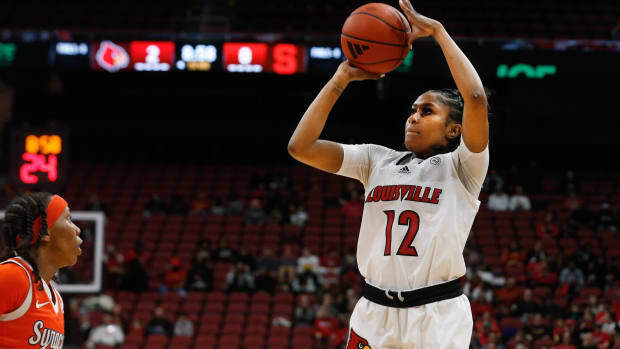
LOUISVILLE, Ky. – A new era of Louisville men’s basketball is here. Last week, the Cardinals tabbed College of Charleston’s Pat Kelsey as their new head coach, replacing second-year head coach Kenny Payne.
Now that Louisville has its new head coach place, now comes the arduous task of trying to recruit almost an entirely new roster. As of Apr. 1, 10 players have entered the transfer portal for the Cardinals, and the only player in line to return from the Payne era is Ty-Laur Johnson.
Keep Watching
Of course, players who entered the portal have the option to return, but Kelsey will still need to bring in new players for his first year at the helm. Well, that’s exactly what he did this past weekend.
On Saturday, transfer guard Reyne Smith announced that he had committed to Louisville, then transfer center James Scott did so on Sunday. Both players are following Kelsey from Charleston, with Smith playing his first three years with the Cougars and Scott playing his true freshman campaign with them.
Smith, a 6-foot-2, 190-pound two-guard, was one of the top players for the Cougars this past season. Playing in all 35 of Charleston’s games while making 28 starts, he was their leading scorer at 12.8 points per games, while also averaging 2.1 rebounds and 1.7 assists. He was named All-CAA Second Team for his efforts.
As for Scott, a 6-foot-11, 210-pound big man, he was a regular rotational contributor for the Cougars this past season. Playing in all 35 games while making four starts, Scott averaged 5.0 points, 3.4 rebounds and 1.3 blocks, while also leading the team in field goal percentage at an astounding 79.2 percent.
But beyond their stat lines, what else do Smith and Scott bring to the table for the Cardinals?
We’ll start with Smith. First and foremost, he is the epitome of a three-point specialist. The southpaw connected on 39.4 percent of his threes, with 112 of his 133 made field goals and 284 of his 324 attempts coming from beyond the arc. He finished the season 15th in all of D1 in three-point attempts, and eighth in made three-pointers.
Smith’s bread-and-butter are catch-and-shoot above the break three-pointers. In fact, 72 percent of his total field goal attempts came at the top of the keys or on the wings. He’ll sometimes be in the left corner for a three, but those attempts are few and far between.
A large bulk of his threes are spot-up shots that come courtesy of his teammates finding him wide open, but Smith does do a good job at coming off of ball screens and getting a quick shot off as soon as he touches the ball. Though for the most part, seems that a lot of his game comes from teammates helping him get an open shot vs. him creating his own shot.
When not raining threes, Smith’s shots inside the arc typically come on the drive from the wing or in transition. It’s not the most effective shot he has, mainly because he’s usually not the most athletic player on the court, but it’s a solid option if he has a favorable matchup. He’s also a solid passer.
His passes might not make a highlight reel, but they’re fundamentally sound for a two guard and he typically won’t make a boneheaded pass. Defense is without a doubt something that he has to work on, as his BartTorvik 112.2 defensive rating was the second-worst on Charleston’s team.
As for Scott, well, he is pretty much the polar opposite of what Smith is. It’s obvious why he is someone that NBA scouts are starting to take note of: he is super athletic, moves incredibly well for someone who is nearly seven feet tall, and has a very high motor to boot.
Of course, with his physical intangibles, Scott is someone who lives above the rim and wants to dunk everything in sight. All 96 of his shot attempts came around the rim, and 52 of his 76 made field goals were dunks. In fact, Scott finished tied for 23rd in all of D1 in dunks.
His dunks and field goals, while limited to just the painted area, do come in a variety of ways. For someone of his stature, he’s very good at quick cuts to the rim to receive a pass and subsequent dunk, and is excellent in pick-and-roll situations. He’s an excellent finisher around the rim, despite the fact that he actually doesn’t have a ton of post moves at his disposal.
Another strength of his is using his length and athleticism to snatch missed shots for offensive rebounds and turn them into relatively easy put backs. As you can imagine, he’s also an adept shot blocker, doing a good job at both staying with his man or shifting in zone defense to make the block – though he does leave his feet sometimes.
Something else to note with Scott is that he averaged just 16.1 minutes per game. While his stat line on the season might not be that impressive, his per-40 minutes stat line comes out to 12.4 points, 8.4 rebounds and 3.2 blocks per game.
Bottom line: these are two very good pickups for Louisville. Scott likely has the higher upside at the power conference level, but both of these players should have defined roles regardless of how the rest of the roster shakes out. Smith probably projects as a go-to bench option for the backcourt, and could be a pseudo-starter against teams with weak three-point defense. Scott will probably be a key reserve for the front court, but could also one day push to be the regular starting center if he can add some true post moves to his toolbox.
Of course, Louisville still needs to hit the transfer portal recruiting trail hard. But they’re off to a good start in regards to building towards year one of the Pat Kelsey era.
Leave a Reply